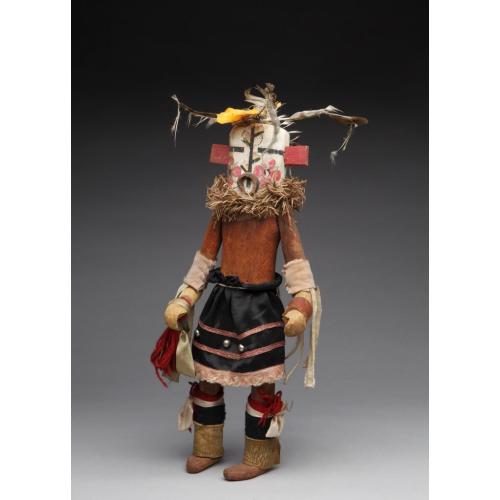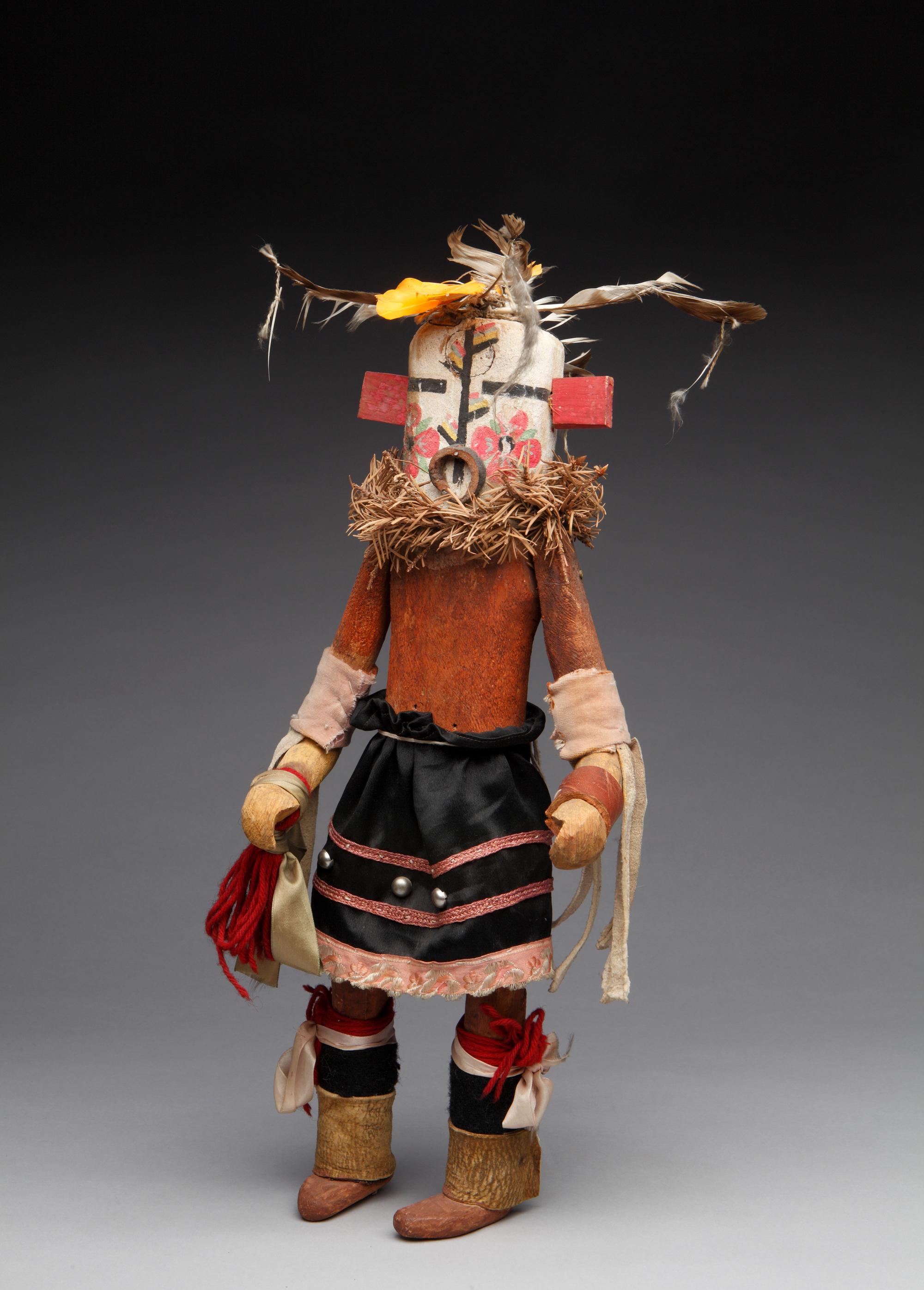
Photograph by Addison Doty. Copyright 2014 School for Advanced Research.
Nahalisho kokko we'ha | Nahalisho kokko figure
Date: before 1952
Artist or Maker: Unknown
Dimensions:
Overall: 45.7 x 19.1 x 20.3 cm (18 x 7 1/2 x 8 in.)
Medium: wood | paints | feathers | cloth, synthetic | leather | metal, iron | metal
Credit Line: Indian Arts Fund purchase for inclusion in the Mary Austin Memorial Collection.
Place Made:
Zuni Pueblo, McKinley County, New Mexico, Southwest, United States, North America
Object Number: IAF.C251
Not on view
Tribal Collection Review RemarksJim Enote and Octavius Seowtewa during collection review visit April 6 and 7, 2009 (Events Record “Collection Review: Zuni Tribe, Review 1”): Nahalisho comes with the Deer dancers. His name is derived from the Zuni words "na'le," meaning deer, and "lishe," meaning spirited or active. De-Ne-Na-Kwe (SAR.1989-7-32) is the singer for this group of dancers.
ADDITIONAL INFORMATION: As per Jim Enote and Octavius Seowtewa during collection review visit April 10 and 11, 2014 (Events Record “Collection Review: Zuni Tribe, Review 13”): This kokko figure is carved from wood, possibly cottonwood or pine. The paints used on the piece appear to be a combination of commercial paints and natural pigment paints. Its head and face are painted white with gypsum paint. There are a pair of red, four-petal flowers on its cheeks, and a corn stalk in the center of the face. The colors used on the corn plant and ears may represent the four directions. There are four red-tailed hawk feathers on top of the figure’s head, set at ninety degrees to each other (they look a little like a propeller). Each tip has a turkey down feather tied to it with a piece of white string. Though hawk feathers are used on this particular figure, they would be turkey wing feathers on the actual dancer. The tips on the ends of the turkey feathers would be either turkey down (fluff) or turkey breast feathers. In the center, where the four turkey feathers would meet on the dancer, there would be several multi-colored feathers, either dyed white turkey feathers or macaw feathers. On this figure, there were some orange dyed feathers tucked underneath the hawk feathers, which should have been on top, in the center between the hawk feathers. (IARC staff member Laura Elliff removed them from under the hawk feathers and put them back in the center, where they would have been located originally. It was later re-photographed to show it with its correctly arranged feathers.) There is nothing painted on the back of the head; this dancer usually has ears of corn painted on the back of its head. The ears on this piece are square and painted red; they should be rounded, not squared. There are no earrings on it because these dancers don’t wear earrings. The mouth is made from a piece of leather, held in place with two finishing nails. This is one of four variations that can be used for this dancer’s mouth. The four versions are a small, red one (similar to the one used on this figure); a longer, rounded one; a long, square one; and a beak-like one with four spikes. There are brownish spots on the back of the head that are stains.
The evergreen ruff around the neck is probably made of Douglas Fir or Blue Spruce. Most of the needles are still present and intact, though very dry and brittle.
The figure’s torso and upper arms are painted with a reddish wood stain or possibly red hematite. The forearms and hands are painted with yellow ochre (“hałuptsikwa” in Zuni). The arms are articulated at the shoulders and attached to the body with a nail through each shoulder. The figure wears pink velvet armbands with long leather fringe on its upper arms. The right wrist has a red yard and a green ribbon on it. (On the actual dancer, these would appear on both wrists.) The left arm has a red leather bow guard on it.
The figure wears a kilt made of a shiny black material with two pink applique ribbons on it and a pink ribbon with white machine embroidery on it at the bottom edge. The kilt has three metal buttons on it (would be silver pins on the dancer). It’s tied onto the figure at the waist with white cotton string. The actual dancer would wear a brocade sash over top of the kilt, with a red, black, and green sash belt over that, and a concho belt on top. (The conservator who treated this piece in 2002, Bettina Raphael, thought this kilt might have been a later replacement and that it might have originally worn a different kind of kilt, but it’s likely original because these dancers really do wear a black kilt.)
The legs are painted the same reddish color as the torso and upper arms. There is red yarn and a pink ribbon tied on each leg, just below the knees. Black leggings are visible on the figure’s calves between the pink ribbon and the leather leg wraps that cover the lower calves and tops of the moccasins. The moccasins are painted with reddish clay to approximate the color of red moccasins.
There are some pieces missing from the kokko’s outfit as compared to what the dancer would wear. The figure is missing a large turquoise necklace and also a silver or turquoise bracelet that should be on the right wrist. It’s missing the fox pelt that would be tied in the back, over the kilt. The actual dancer would not be allowed to leave the kiva without the fox pelt.
In Collection(s)
The Indian Arts Research Center, in collaboration with Native American community scholars, strives to present accurate collections records. Records may be updated as new information becomes available and is reviewed with the Native American community having cultural affinity to particular items. Please write to iarc@sarsf.org if you have questions or concerns related to the documentation.
